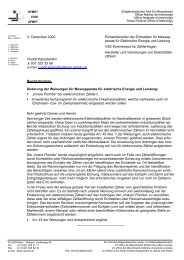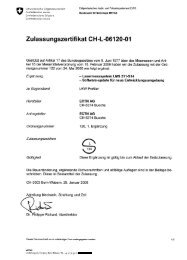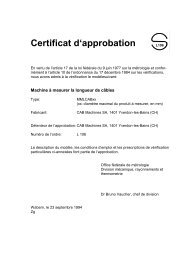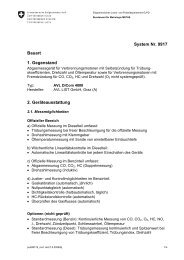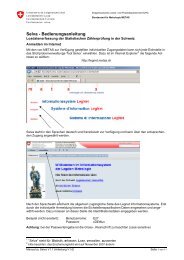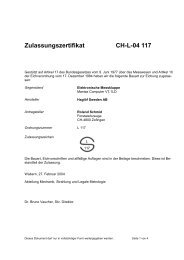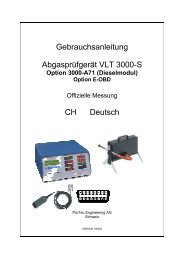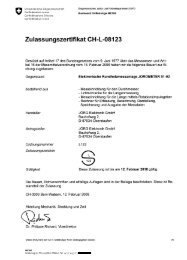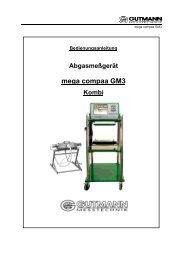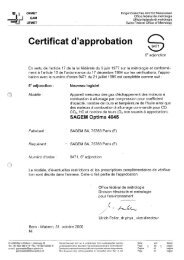You also want an ePaper? Increase the reach of your titles
YUMPU automatically turns print PDFs into web optimized ePapers that Google loves.
2. Safety instructions<br />
Mains voltages<br />
High voltage<br />
Danger of acid burning<br />
Hazardous voltages occur in both the lighting system and the<br />
electrical system of a motor vehicle. If contact is made with live<br />
parts (e.g. with the ignition coil), there is a risk of electric shock<br />
from flashover voltages caused by damaged insulation (e.g.<br />
ignition cables which have been attacked by martens). This<br />
applies to both the primary side and the secondary side of the<br />
ignition system, to the cable harness and the plug connections,<br />
to the lighting systems (Litronic) and to the tester connections.<br />
Safety precautions:<br />
- All testers must be connected to properly grounded, shockproof<br />
sockets (in accordance with VDE 0100 or the corresponding<br />
country-specific regulations).<br />
- Testers must always be connected using the power cables<br />
supplied with them.<br />
- All extension cables must be fitted with shock-proof contacts.<br />
- Any cables with damaged insulation must be replaced (e.g.<br />
power or ignition cables).<br />
- Connect testers to the lighting system and switch them on<br />
before connecting them to the vehicle.<br />
- Connect testers to the engine ground or to the battery (B-)<br />
before switching on the ignition.<br />
- Always switch off the ignition before performing any work on<br />
the electrical system of the vehicle. The term „work“ includes<br />
connecting testers, replacing parts of the ignition system,<br />
removing assemblies (e.g. generators), connecting assemblies<br />
to a test bench, etc.<br />
- Wherever possible, tests and settings should always be carried<br />
out with the ignition switched off and the engine stationary.<br />
- If tests or settings are carried out with the ignition switched on<br />
or the engine running, care must be taken not to touch any live<br />
parts. This applies to all the connecting cables of the testers<br />
as well as to the connections of any assemblies at the test bench.<br />
- Test connections must always be made using suitable connectors<br />
(e.g. Bosch testing cable set or vehicle-specific adapter cables).<br />
- Make sure that all test connections are properly plugged in and<br />
secure.<br />
- Switch off the ignition before disconnecting the tester from the<br />
engine ground or the battery (B-).<br />
- Never open the casing of the screen.<br />
- Never open the housing of the tester.<br />
Danger of Implosion<br />
There is a danger of the screen tube imploding if the screen is<br />
improperly handled (e.g. the tube is subjected to some form of<br />
impact, sudden temperature change, the glass is damaged).<br />
Safety precautions:<br />
- Make sure that the screen is well vented so that heat can<br />
properly dissipate.<br />
- Never cover the vents (e.g. with a towel) while the screen in<br />
switched on.<br />
- Never allow a fluid to penetrate the screen.<br />
- Place the screen away from direct sunlight.<br />
When exhaust gas measurements are taken, the sampling<br />
hoses which are used release a highly caustic gas<br />
(hydrogen fluoride) that can cause acid burning in the respiratory<br />
system when heated to temperatures in excess of 250 °C<br />
(482 °F) or in the event of fire.<br />
Rules of conduct:<br />
- Consult a doctor immediately after inhaling!<br />
- Always wear gloves made of neoprene or PVC<br />
when removing residues left after a fire.<br />
- Neutralize any residues left after a fire with a calcium hydroxide<br />
solution. This produces non-toxic calcium fluoride, which can<br />
be washed away.<br />
Acids and alkalis can cause severe burning on unprotected<br />
skin. Hydrogen fluoride in combination with moisture (water)<br />
forms hydrofluoric acid.<br />
The condensate which accumulates in the sampling hose and<br />
in the condensate container likewise contains acid.<br />
When replacing the O 2<br />
measuring sensor, bear in mind that it<br />
contains alkali.<br />
When replacing the NO measuring sensor, bear in mind that<br />
it contains acid.<br />
Rules of conduct:<br />
- Rinse any affected parts of the skin immediately in water, then<br />
consult a doctor!<br />
- NO and O 2<br />
measuring sensors are hazardous waste and must<br />
be disposed of separately. Your Bosch specialist equipper can<br />
dispose of sensors in the proper manner.<br />
If liquid crystal escapes from a damaged liquid crystal display,<br />
it is imperative to avoid direct skin contact, inhalation and<br />
swallowing.<br />
Rules of conduct:<br />
- Wash the skin and clothing thoroughly with soap and water if it<br />
has come into contact with liquid crystal.<br />
- If you have inhaled or swallowed liquid crystal, consult a doctor<br />
immediately!<br />
If fluid (electrolyte) escapes from batteries and rechargeable<br />
batteries, avoid getting it on your skin or in your eyes.<br />
Rules of conduct:<br />
- If contact with skin or eyes happens nevertheless, wash the<br />
affected parts immediately with clean water and then consult<br />
a doctor.<br />
14



